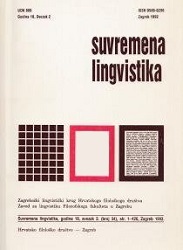Imiesłów przymiotnikowy czynny u poljskom jeziku i njegovi hrvatski prijevodni ekvivalenti
Imiesłów przysłówkowy czynny in Polish and its Croatian translation equivalents
Author(s): Paulina Pycia-KošćakSubject(s): Morphology, Syntax, Semantics, Comparative Linguistics, Western Slavic Languages, South Slavic Languages, Translation Studies
Published by: Hrvatsko filološko društvo
Keywords: participles; translation equivalents; Polish language; Croatian language;
Summary/Abstract: Polish and Croatian inherited some of the participles from the Old Slavonic language, significantly narrowing their number and simplifying their forms. Their development was different, due to the peculiarities of each language system. One of them, participium praesentis activi (Pol. imiesłów czasu teraźniejszego czynny, Cro. glagolski prilog sadašnji aktivni / aktivni particip prezenta) developed in Polish into two separate (morphologically, syntactically and semantically different) verb forms: invariable imiesłów przysłówkowy współczesny with the suffix –ąc and the variable imiesłów przymiotnikowy czynny with the suffixes –ący for the masculine gender, –ąca for the feminine gender and –ące for the middle gender. While the first of them has its unambiguous equivalent in the Croatian language, glagolski prilog sadašnji with the suffix –ći, the second forces the translator to find some other solutions. Among them are various transformations at the formal level aimed at conveying the content of the original text. The paper examines translation equivalents on the example of contemporary Polish and Croatian prose (see Literature) in such a way that constructions in the original language are opposed their equivalent structures in another language and their formal and semantic properties are described.
Journal: Suvremena lingvistika
- Issue Year: 48/2022
- Issue No: 94
- Page Range: 209-221
- Page Count: 13
- Language: Croatian

